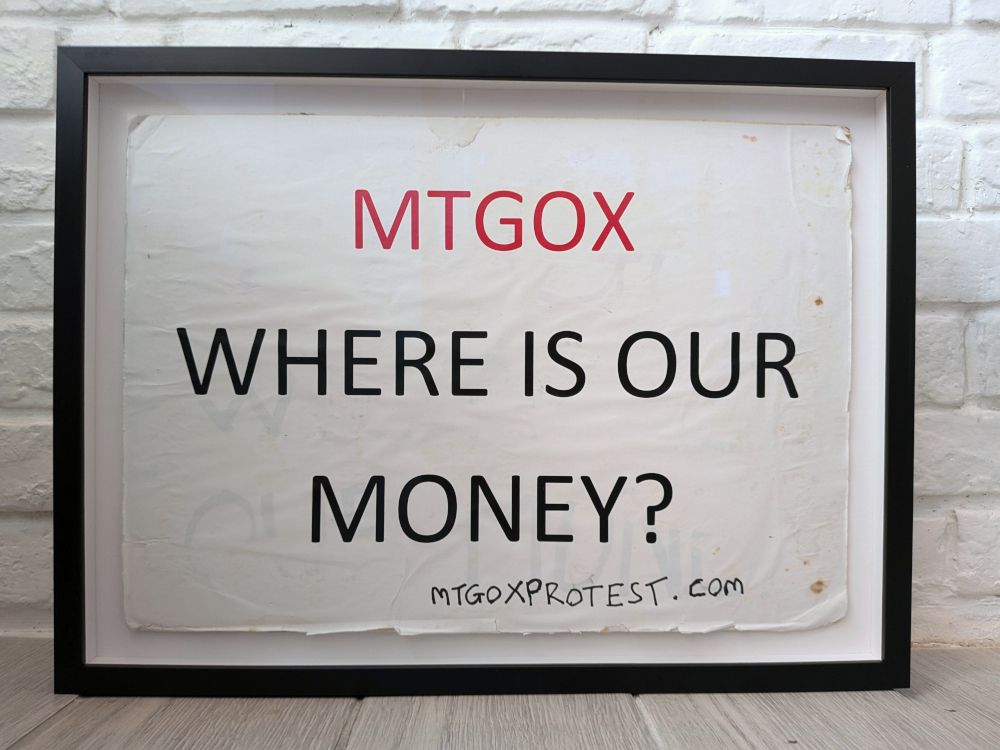On a chilly February morning in 2014, Kolin Burges found himself standing outside the Tokyo office of Mt. Gox, holding up a hand-written cardboard sign and seeking answers from the CEO,...
Read moreOn a chilly February morning in 2014, Kolin Burges found himself standing outside the Tokyo office of Mt. Gox, holding up a hand-written cardboard sign and seeking answers from the CEO, Mark Karpeles, regarding his missing cryptocurrency.
Fast forward 11 years, and the iconic sign that symbolizes one of crypto’s biggest financial scandals is up for auction on Scarce.City, with a starting price of 4.5 BTC (equivalent to $383,000). The auction commences on Friday and concludes on April 3rd.
“In the beginning, I never imagined that the sign could become valuable,” said Burges during an interview in Hong Kong with CoinDesk. “I had thought that maybe one day I would write a book, but I never considered the sign itself to be significant. It’s fascinating how things have developed over time.”
Burges had flown from London to Tokyo after Mt. Gox, the leading bitcoin exchange globally at that time, inexplicably halted withdrawals.
“I woke up one day knowing I had to go to Tokyo,” Burges recounted. “I didn’t have a concrete plan, but I felt compelled to be there.”
“When the withdrawal didn’t go through, I started feeling a sense of unease,” he continued. “Initially, I wasn’t fully certain, but as time passed, it became apparent that something was seriously amiss.”
His spontaneous protest quickly garnered attention from international media outlets, including mainstream financial press like the Wall Street Journal.
Burges described those initial days in Tokyo as surreal and almost like a dream.
“The moment I confronted Karpeles was intense,” he recalled. “I demanded answers, but he dismissed me, attributing the issues to technical problems. It felt surreal, standing there in the snow, sensing that something momentous was unfolding.”
While Burges protested outside Mt. Gox’s offices, the exchange’s efforts to contain the public backlash became increasingly evident.
“Mt. Gox tried to offer hope, but it was apparent to everyone that the situation was deteriorating rapidly,” Burges mentioned. “They even invited us inside to protest in private, attempting to keep us away from the public eye. It was a desperate and farcical situation.”
Burges remembered how, over drinks, a Mt. Gox representative, whose identity he chose not to disclose, attempted to convince him to stop.
“At one point, representatives from Mt. Gox met with me privately, warning that continued protests could lead to the exchange’s collapse and result in the loss of everyone’s bitcoins,” he stated. “This conversation indicated that they knew more than they were admitting, and the situation was much worse than what was being disclosed.”
At one point, Burges recalled, a representative from Mt. Gox tried to pay for their beverages with a Mt. Gox credit card – only for it to be declined.
“It was a foreboding sign that their banking relationships were falling apart,” Burges remarked.
Mt. Gox declared bankruptcy in February 2014, just days after Burges initiated his protest.
Seven years later, Karpeles was acquitted of embezzlement charges in a Tokyo court while receiving a suspended sentence for data manipulation.
In September, Karpeles launched a new crypto exchange called EllipX. He also set up a crypto ratings company, Ungox, in 2022.
During an interview with CoinDesk at Korea Blockchain Week in August 2024, Karpeles stated that if he had access to modern blockchain analytical tools and third-party custodians in 2014, the Mt. Gox debacle could have been avoided.
- [posts_like_dislike id=707]
